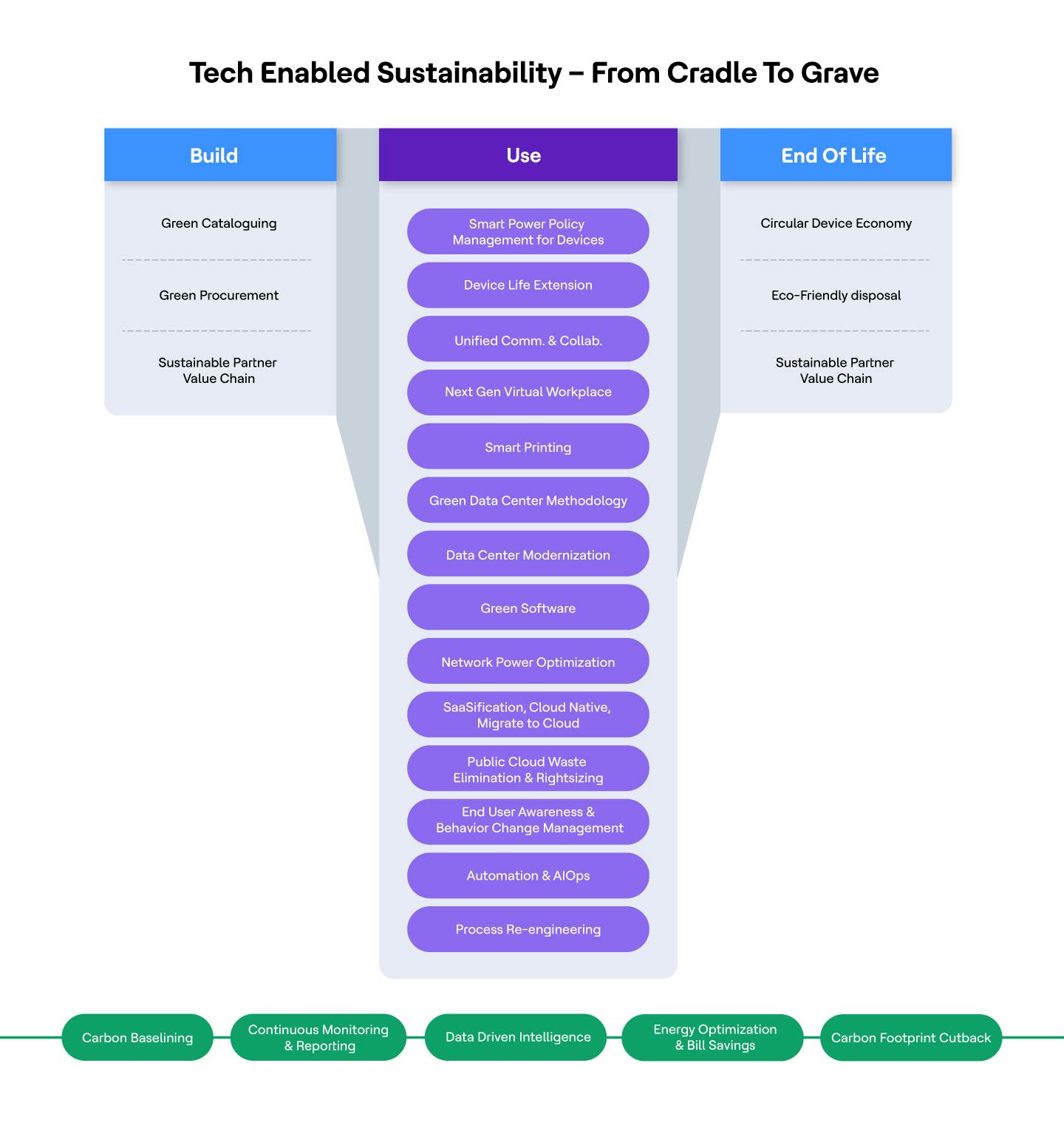There is indisputable evidence that the Earth is warming at an unprecedented rate due to human activity. Scientists are now able to predict, with a high degree of accuracy, the extent of the devastation that climate change could wreak if it goes unchecked. For instance, climate change is expected to cause 250,000 additional deaths per year between 2030 and 2050.
The fallout won’t be restricted to low-lying areas or vulnerable populations. As the planet heats up, people and businesses alike will find themselves grappling with power crisis. Businesses are already struggling to cope with the escalating energy costs triggered by rising oil and gas prices. The alternative, which is renewables, is the cheapest form of power today, but it has’t reached a share of even 30% of global electricity production. Our reliance on electricity is growing every day as digitalization becomes more invasive. How can we then reduce technology-induced green house gas (GHG) emissions?
The ICT sector emits about 730 million tons of CO2 every year, accounting for about 2% of total GHG emissions. This is comparable to the airline industry, which is considered as one of the major polluters. And just as customers are now keen to make ethical and environmentally conscious purchasing decisions, businesses too are looking to run their technology in sustainable, energy-efficient ways. Research shows that customers demand a reduction of up to 40% in the IT carbon footprint despite growing IT requirements. This represents a huge opportunity for tech-enabled sustainability initiatives and it also means that IT infrastructure, that can meet the growing needs of users while also being sustainable and eco-friendly, is a sure path to longevity and success.
Milestones in The Roadmap to Sustainable IT
Today, the biggest challenge is: How do you empower and scale your business, while staying sustainable? The answer starts with decoupling IT infrastructure growth ambitions from hikes in carbon emissions. Decarbonizing IT calls for a holistic and inclusive approach, including:
- Data centers that host servers and associated components for storing, processing and disseminating data
- Local sites for remote processing
- End-user device estate
- Network that interconnects systems locally and globally
Compared with on-premises deployment, cloud computing is more sustainable. As per research, this is because of higher cloud server utilization rates, faster equipment refresh speed, novel methods to reduce power consumption and renewable energy resources.
Another study shows that a renowned hyperscaler can lower customers’ workload carbon footprints by 80% compared to surveyed enterprise data centers, and 96% once powered with 100% renewable energy, a target they plan to meet by 2025.
Business leaders must consider all these aspects for carbon footprint calculations. They must:
- Capture the embodied, operational and end-of-life CO2 emissions related to each scope
- Derive meaning from that data
- Identify and pull the levers to mitigate associated carbon emissions
This is the key to achieving a sustainable IT infrastructure.
Sustainability across The IT Lifecycle
Every aspect of modern information technology—from the smallest chip to the largest data center— carries a carbon price tag, and green computing seeks to reduce the same. A green IT lifecycle starts with procuring the right, energy efficient device models with high energy star ratings from environment conscious OEM partners, basis a well-defined green catalogue of role-based device model list.
This must also consider eco-friendly packaging and minimal emissions at the dispatch stage.
The build stage isn’t restricted to devices, but includes concepts of green software. Next is ensuring optimum energy utilization at the use stage, and finally reducing negative impact to the environment during the end of life stage.
As per studies, the manufacturing process has the biggest share in the overall carbon footprint of a laptop. Without doing anything else, purchasing a refurbished laptop under the circular device economy concept would help reduce the carbon footprint of buying a laptop by approximately 85%.

Building a Sustainable IT Framework
A holistic sustainability framework helps organizations to use technology in a sustainable, smarter and cleaner way by reducing scope 1, 2 and 3 emissions. It limits the use of hazardous sources at the IT build stage through green procurement and using resources judiciously by plugging in the concepts of the circular economy. It is a must-have for enterprises seeking to minimize carbon footprint.
Ideally, a sustainability framework targeted at IT infrastructure has a clear, four-phased approach:
Target
Set IT-specific sustainability targets in line with organizational objectives to ensure a goal-based performance tracking.
Measure
Identify where the organization stands today by defining a clear baseline of kg CO2 emissions from IT infrastructure and real-time reporting of these metrics. This also helps in complying with regulations and industry certifications.
Extract
Apply AI-powered advanced analytics to obtain meaningful insights. This includes impact visualization that enables forecasting the translated impact of pulling specific levers on the carbon footprint and cost savings.
Act
Create a dedicated ‘sustainability office’ that assumes stewardship of agreed sustainability framework actions with best-in-class sustainable practices, tools and technologies to deliver required outcomes.
The HCLTech Advantage
For us, sustainability is at the core of how we deliver our Digital Foundation (DF) services. We strongly believe in the need to make conscientious business decisions that safeguard the future of generations.
And to help some of the world’s foremost enterprises meet their business and sustainability goals, we’ve successfully delivered planet-friendly technology solutions. This includes solutions for virtualization, containerization, software-defined technology for private DC modernization and public cloud waste elimination—through HCLTech’s DRYiCE FinOps.
Our workplace solutions comprise green cataloging and procurement, circular economy, smart power management, virtual 3D immersive spaces and AR-based remote support—from the HCLTech Fluid Workplace suite.
Our CloudSMART approach helps organizations to make intelligent choices for a resilient and sustainable business through innovative cloud services that are driven by intelligent automation and a powerful partner ecosystem. And the diverse Digital Foundation levers push organizations towards becoming carbon-neutral or negative and sustainably future-ready.
Want to better understand our unique tech-enabled sustainability framework?
Get in touch with shivangi_sharma@hcltech.com.


